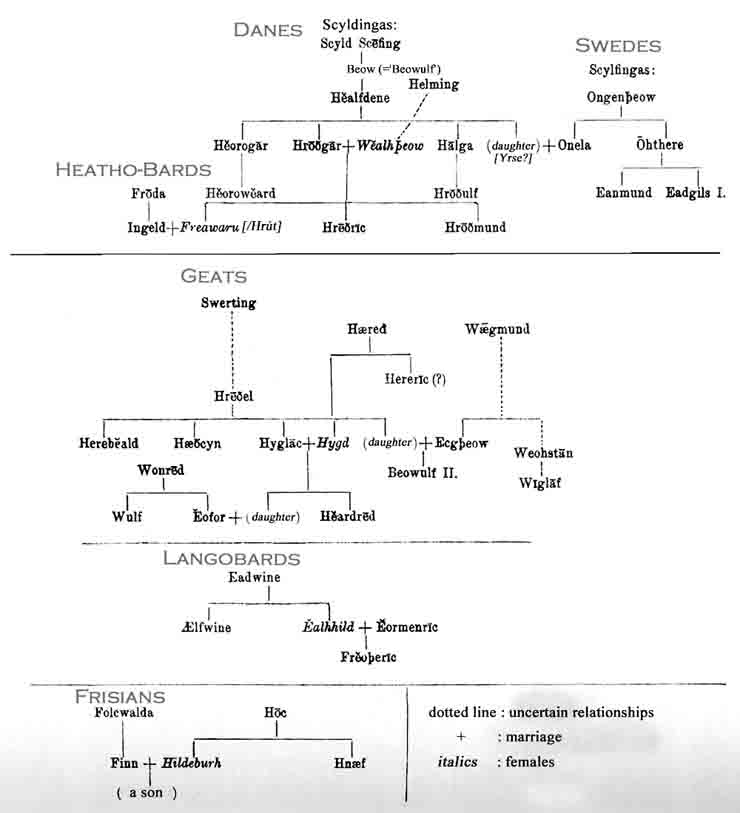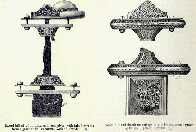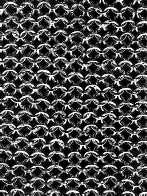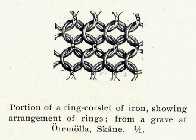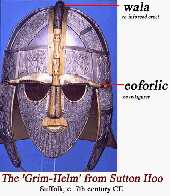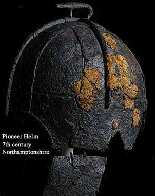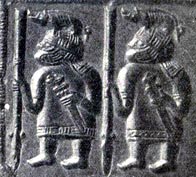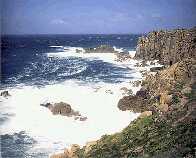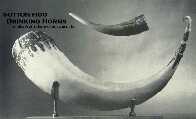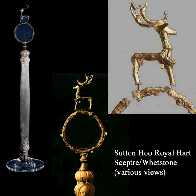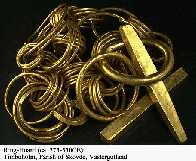Beowulf on Steorarume
Genealogies, Maps, Glossary & Pictoral Guide to Beowulf
(click on images for larger view)
INDEX
see also Syd Allan's Beowulf glossary for more definitions
Genealogies
Maps
Scandinavia
England
East Anglia
Glossary
Weapons & Armour
bill
maiche
brand
sedge
seax
ring-sword
wave-sword
byrnie
grim-helm
wala
boar-helm
shield-boss
Nautical Terms
keel
prow
Geographical Terms
strait
sound
headland
fen
mere
moor
heath
barrow
Food, Drink, Recreation
mead
harp/lyre
Men & Monsters
thane
shuck
shine
nicor
Treasure
ring-hoard
Scandinavia (setting of the poem)
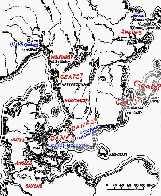
Anglo-Saxon England
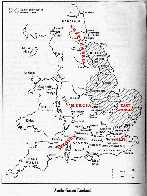
East Anglia
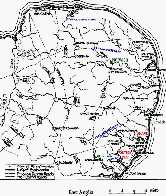
(OED = citations from the Oxford English Dictionary)
[** after a word indicates a new coining, used for words which did not survive into Modern English]
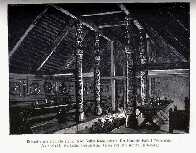
reconstructed 'mead-hall'
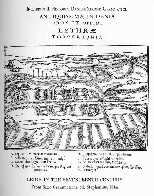
Leire (Zeeland) in the 17th-c., from Saxo Grammaticus (1644)
bill/bil [cf. Brady 1979] - a long, two-edged
sword used primarily for hewing (rather than thrusting), though it
seems to have had a sharp rather than rounded point - in Beo.
it seems to be distinguished from the maiche [ mece
] (see below), though the basis for this distinction is unclear. [** after a word indicates a new coining, used for words which did not survive into Modern English]

reconstructed 'mead-hall'

Leire (Zeeland) in the 17th-c., from Saxo Grammaticus (1644)
OED :- 'from OTeut. *biljo-(m (with WGer. ll for lj), connected by some with Skr. bhil to split, cleave. Applied to various cutting weapons and implements, the relations of which to each other are not satisfactorily ascertained. (Ger. beil , OHG. bîhal , is an entirely different word.); (1 - obs. ) a weapon of war mentioned in OE. poetry, a kind of broadsword, a falchion'.
Not to be confused with the later meaning of bill :- '(2) An obsolete military weapon used chiefly by infantry; varying in form from a simple concave blade with a long wooden handle, to a kind of concave axe with a spike at the back and its shaft terminating in a spear-head; a halberd' (OED).
Germanic two-edged sword
maiche** (OE. mece) - [cf.
Brady 1979] - a long, two-edged sword used primarily for hewing (rather
than thrusting), though it seems to have had a sharp rather than
rounded point - in Beo. it seems to be distinguished from the
bill (see above), though the basis for this distinction
is unclear.
No entry in the OED.
brond/brand - Brady (1979) believes this to refer to a short sword designed primarily for thrusting rather than hewing, but it may just be a variation for the general sense of sweord 'sword'.
sedge (OE secg) - seemingly, as Brady (1979) suggests: a short, thrusting sword, as in OE secg is used to gloss Latin gladiolus.
OED :- 'OTeut. type *sagjo-z, f. root *sag- (:—Indogermanic *sek-: *sek- in L. secare to cut): cf. saw'
Cf. also the modern English sedge, meaning (OED): '(1) A name for various coarse grassy, rush-like or flag-like plants growing in wet places; also (in different localities) variously applied spec., e.g. to the cyperaceous genera Carex and Cladium , to the Sweet Flag (Acorus ) and the Wild Iris (Iris Pseudacorus )' - these plants have 'blade-shaped' leaves, a meaning also present in OE.
In OE, secg refers to a 'blade' in the feminine, but to a 'warrior, man' in the masculine.
seax - a short, one-edged sword.
OED :- 'OTeut. *sahsom, f. root *sah-, sag - to cut: cf. saw'

rune-engraved seax found in the River Thames
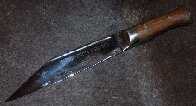

modern reproduction seax - from Himalayan Imports / BirGorkha Khukuri (Nepal)
[(left) runic inscription = 'SHER-MEC-WOERHTE' (="Sher (the name of the Nepali blacksmith) made me")]
[(right) runic inscription = 'SLÆDE-MEC-ÆH' (="Slade owns me")]
[rune-etching done by Keith Sauers]
No entry in the OED.
brond/brand - Brady (1979) believes this to refer to a short sword designed primarily for thrusting rather than hewing, but it may just be a variation for the general sense of sweord 'sword'.
sedge (OE secg) - seemingly, as Brady (1979) suggests: a short, thrusting sword, as in OE secg is used to gloss Latin gladiolus.
OED :- 'OTeut. type *sagjo-z, f. root *sag- (:—Indogermanic *sek-: *sek- in L. secare to cut): cf. saw'
Cf. also the modern English sedge, meaning (OED): '(1) A name for various coarse grassy, rush-like or flag-like plants growing in wet places; also (in different localities) variously applied spec., e.g. to the cyperaceous genera Carex and Cladium , to the Sweet Flag (Acorus ) and the Wild Iris (Iris Pseudacorus )' - these plants have 'blade-shaped' leaves, a meaning also present in OE.
In OE, secg refers to a 'blade' in the feminine, but to a 'warrior, man' in the masculine.
seax - a short, one-edged sword.
OED :- 'OTeut. *sahsom, f. root *sah-, sag - to cut: cf. saw'

rune-engraved seax found in the River Thames


modern reproduction seax - from Himalayan Imports / BirGorkha Khukuri (Nepal)
[(left) runic inscription = 'SHER-MEC-WOERHTE' (="Sher (the name of the Nepali blacksmith) made me")]
[(right) runic inscription = 'SLÆDE-MEC-ÆH' (="Slade owns me")]
[rune-etching done by Keith Sauers]
ring-sword/hilt - a sword whose hilt bears
an ornamental ring, whose significance is unclear, but may have been
ceremonial, involving the swearing of oaths (cf. Davidson's The
Sword in Anglo-Saxon England, esp. 71-7, 177ff.)
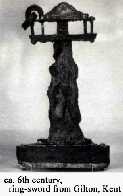
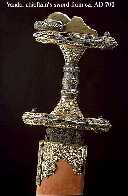
two 'ring-sword' hilts
grimhelm - helmets which include a metal 'mask', concealing and protecting the face.
wala - a re-inforced crest running sagittally over a helmet.
boar (helm) [eofor] - a helmet topped with a figure of a boar, thought to have be something of an amulet of protection
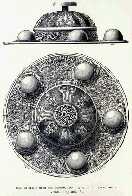
shield-boss
prow - The fore-part of a boat or ship; the part immediately about the stem ['stem'=the timber at an extermity of a vessel] (OED).
Geographic Terms
strait - A comparatively narrow water-way or passage connecting two large bodies of water (OED).
sound - A relatively narrow channel or stretch of water, esp. one between the mainland and an island, or connecting two large bodies of water; a strait. Also, an inlet of the sea (OED).
headland - A point of land projecting into the sea or other expanse of water; a cape or promontory: now usually, a bold or lofty promontory (OED).
fen - Low land covered wholly or partially with shallow water, or subject to frequent inundations; a tract of such land, a marsh (OED).
mere - A sheet of standing water; a lake, pond; an arm of the ocean (OED).
moor - A tract of unenclosed waste ground; now usually, uncultivated ground covered with heather; a heath (OED).
heath - Open uncultivated ground; an extensive tract of waste land; a wilderness; now chiefly applied to a bare, more or less flat, tract of land, naturally clothed with low herbage and dwarf shrubs, esp. with the shrubby plants known as heath, heather or ling (OED).
barrow - A mound of earth or stones erected in early times over a grave; a grave-mound, a tumulus (OED).
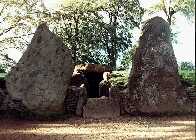
a barrow known as Wayland's Smithy,
located on the Berkshire Downs (England),
about a half mile from Uffington Castle

mead - An alcoholic liquor made by fermenting a mixture of honey and water (OED).
Men & Monsters
thane - One who in Anglo-Saxon times held lands of the king or other superior by military service; originally in the fuller designation cyninges þegn , ‘king's thane, military servant or attendant’; in later times simply thegn , as a term of rank, including several grades below that of an ealdorman or eorl and above that of the ceorl or ordinary freeman (OED).
shuck- 1. A devil, fiend (obs.); 2. a spectral hound (dial. ) (OED). Particularly prominent in East Anglia to refer specifically to the 'Barguest' type of Black Dog, a corporal supernatural creature; Brown (189) describes the 'Barguest' type as '...not essentially a dog, but a shapeless monster...a subconscious, partly chthonic entity'; cf. 'Shuck' or 'Old Shock' in Forby.
shine ** - a spectral sort of creature, likely related to the will-o'-the-wisp, possibly restricted to fens and marshes
nicor - An imaginary being supposed to live in the water; a water-demon, kelpie, river-horse (OED).
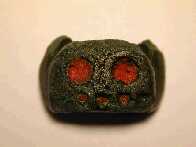
Viking 'goblin' skull-face, with bright red enamel, possibly hilt from small votive knife,
found in Burnham Market, Norfolk, 9th-10th c., private collection
Treasure
ring-hoard - The 'treasury' of a nation or people; often made up literally of gold formed into large rings, sometimes linked together.


two 'ring-sword' hilts
| see further: |
Royal Sword: Hilt - Sutton Hoo sword fittings, @wuffings.co.uk |
Royal Sword Belt - Sutton Hoo belt, @wuffings.co.uk |
wave-sword [waégsweord]/braid-marked
(sword) [wundenmaél]/wave-marked (sword) [bródenmaél]/serpent-patterned
(sword) [wyrmfáh] - possible kennings for pattern-welded
swords, swords of superior quality made by twisting together steel
rods in the forging process, producing various 'wave' patterns on the
surface of the metal.
byrnie - generally a short coat (not reaching
below the waist) with short sleeves (above the elbow) of mail, or
'chainmail'. This mail was constructed of rows of interlocking small
rings (a little less than half an inch in diameter), each one passed
through four other rings and linked together by riveting or welding or
both, or in alternating rows of riveted and welded rings.
OED :- 'Scottish variant of ME. brynie, brinie, with metathesis of r. The word was thus brought nearer to OE. byrne , from which however it could not directly come, as this gave only the monosyllabic *byrn'
OED :- 'Scottish variant of ME. brynie, brinie, with metathesis of r. The word was thus brought nearer to OE. byrne , from which however it could not directly come, as this gave only the monosyllabic *byrn'
grimhelm - helmets which include a metal 'mask', concealing and protecting the face.
wala - a re-inforced crest running sagittally over a helmet.
boar (helm) [eofor] - a helmet topped with a figure of a boar, thought to have be something of an amulet of protection
| see further: |
| see further: |

shield-boss
model of the Viking ship from Oseberg (Norway), ca.
late 9th century
(pictured: replica of ship, christened as Edda, sailing in Heroy fjord in 1988)
keel - The lowest longitudinal timber
of a ship or boat, on which the framework of the whole is built up;
in boats and small vessels forming a prominent central ridge on the
under surface; in iron vessels, a combination of iron plates taking the
place and serving the purpose of the keel of a wooden vessel (OED).(pictured: replica of ship, christened as Edda, sailing in Heroy fjord in 1988)
prow - The fore-part of a boat or ship; the part immediately about the stem ['stem'=the timber at an extermity of a vessel] (OED).
Geographic Terms
strait - A comparatively narrow water-way or passage connecting two large bodies of water (OED).
sound - A relatively narrow channel or stretch of water, esp. one between the mainland and an island, or connecting two large bodies of water; a strait. Also, an inlet of the sea (OED).
headland - A point of land projecting into the sea or other expanse of water; a cape or promontory: now usually, a bold or lofty promontory (OED).
fen - Low land covered wholly or partially with shallow water, or subject to frequent inundations; a tract of such land, a marsh (OED).
mere - A sheet of standing water; a lake, pond; an arm of the ocean (OED).
moor - A tract of unenclosed waste ground; now usually, uncultivated ground covered with heather; a heath (OED).
heath - Open uncultivated ground; an extensive tract of waste land; a wilderness; now chiefly applied to a bare, more or less flat, tract of land, naturally clothed with low herbage and dwarf shrubs, esp. with the shrubby plants known as heath, heather or ling (OED).
barrow - A mound of earth or stones erected in early times over a grave; a grave-mound, a tumulus (OED).

a barrow known as Wayland's Smithy,
located on the Berkshire Downs (England),
about a half mile from Uffington Castle

mead - An alcoholic liquor made by fermenting a mixture of honey and water (OED).
drinking horns
harp/lyre - The Anglo-Saxon
hearpe is properly called a 'lyre' in Modern English: The lyre
seems to have always been six stringed, but how it was played and tuned
will have to remain a mystery. It is possible that each string was tuned
to a different note and then just plucked, although the tunes would
be severely limited with less than an octave range, or it may have been
that a number of strings were used for chords and drones, whilst others
had their note changed by applying pressure to the back of the string and
then plucking for the melody. However it was played there seems to be
a peculiarly English convention of reinforcing the top tenon joints with
a decorative plaque, usually of bronze, riveted through the joint. This
served not only to strengthen the joint but also to decorate the lyre.
The instrument itself was made of wood, with gut or horsehair strings. The
pegs, bridge and tail-piece could be of wood or bone [description from
regia.org].
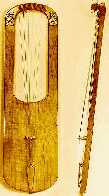
reconstructed harp (or lyre) from Sutton Hoo
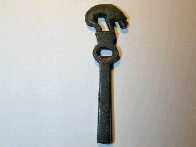

Anglo-Saxon Lyre Tuning Key with Boar terminal,
possibly mid 7th-century, from Gayton, Norfolk, private collection

reconstructed harp (or lyre) from Sutton Hoo


Anglo-Saxon Lyre Tuning Key with Boar terminal,
possibly mid 7th-century, from Gayton, Norfolk, private collection
Men & Monsters
thane - One who in Anglo-Saxon times held lands of the king or other superior by military service; originally in the fuller designation cyninges þegn , ‘king's thane, military servant or attendant’; in later times simply thegn , as a term of rank, including several grades below that of an ealdorman or eorl and above that of the ceorl or ordinary freeman (OED).
shuck- 1. A devil, fiend (obs.); 2. a spectral hound (dial. ) (OED). Particularly prominent in East Anglia to refer specifically to the 'Barguest' type of Black Dog, a corporal supernatural creature; Brown (189) describes the 'Barguest' type as '...not essentially a dog, but a shapeless monster...a subconscious, partly chthonic entity'; cf. 'Shuck' or 'Old Shock' in Forby.
shine ** - a spectral sort of creature, likely related to the will-o'-the-wisp, possibly restricted to fens and marshes
nicor - An imaginary being supposed to live in the water; a water-demon, kelpie, river-horse (OED).

Viking 'goblin' skull-face, with bright red enamel, possibly hilt from small votive knife,
found in Burnham Market, Norfolk, 9th-10th c., private collection
Treasure
ring-hoard - The 'treasury' of a nation or people; often made up literally of gold formed into large rings, sometimes linked together.
ring-hoard

a neck-ring, like the one given Beowulf by Wealhtheow
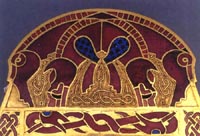
Shoulder-clasp end from Sutton Hoo
- 2 boars in interlocking design
(garnets & millifiore glass / 48mm)

gold buckle from Sutton Hoo, interlace design
(hollow opened with 2 sliding catches at back - 44-5 grammes, 132mm)

a neck-ring, like the one given Beowulf by Wealhtheow

Shoulder-clasp end from Sutton Hoo
- 2 boars in interlocking design
(garnets & millifiore glass / 48mm)

gold buckle from Sutton Hoo, interlace design
(hollow opened with 2 sliding catches at back - 44-5 grammes, 132mm)
